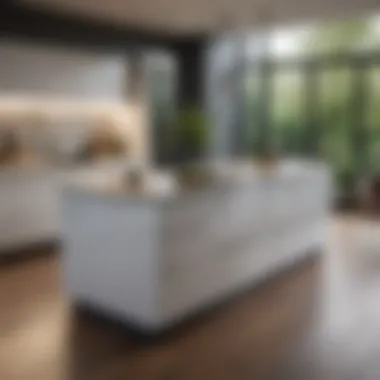Creative Renovation Ideas for Small Kitchens


Intro
Renovating a small kitchen can often feel like an uphill battle. However, with some careful planning and creative thinking, transforming a compact space into a stylish and efficient culinary area is entirely doable. This article aims to provide a thorough exploration of innovative ideas for small kitchen renovations. By focusing on practical solutions that enhance both functionality and aesthetics, we can help homeowners, renters, and anyone passionate about home design to optimize their kitchen space.
Whether you are looking for layout adjustments, choosing the right materials, or considering ways to incorporate more storage, our guide offers valuable insights that reflect modern trends and personal tastes.
Design Inspiration
Design plays a crucial role in shaping how you experience your kitchen, especially when working with limited space. Enhancing a small kitchen often involves an assessment of current trends in interior design coupled with thoughtful decisions about color.
Current Trends in Interior Design
Minimalism continues to dominate interior design, especially for smaller areas. This approach emphasizes decluttering and utilizing multifunctional furniture. Additionally, you may find natural materials such as wood and stone being favored for their warmth and durability. Open shelving is a common choice, providing easy access to essentials while creating a spacious feel.
Another trend is the use of bold accents in thoughtfully chosen locations. This can mean incorporating unique light fixtures or statement backsplashes. These touches can elevate an otherwise simple space, reflecting individual style.
Color Schemes and Palette Ideas
Selecting the right color palette is essential for small kitchen renovations. Lighter shades like whites, pastels, and soft grays can make your kitchen appear larger and more inviting. These colors reflect light, enhancing the overall brightness of the space. On the other hand, deeper hues, such as navy blue or forest green, can add sophistication when used sparingly as accents.
Combining shades can also yield exciting results. For example, pairing a soft cream with deep charcoal can create an elegant yet comfortable atmosphere. Consider using an accent wall to introduce a pop of color without overwhelming the entire space.
"Color selection, when done mindfully, transforms not just a kitchen’s look but also its energy."
Consider using color theory principles to guide your choices. This approach helps to create a harmonious feel that resonates throughout the space.
In summary, the design of a small kitchen is about more than aesthetics; it reflects functionality and personalized style. Engaging in this process requires a solid understanding of current trends and careful color selection to achieve optimal results.
Understanding Kitchen Dimensions
Understanding the dimensions of your kitchen is a fundamental aspect of any renovation project. It lays the groundwork for effective design and influences every decision made during the process. Recognizing the space you have allows homeowners to make educated choices that optimize the functionality, style, and storage potential of a small kitchen.
Accurate measurements help to determine the layout possibilities. A well-measured kitchen can help in identifying the best work zones, ensuring everything is within easy reach. Additionally, understanding dimensions contributes to making informed decisions about appliances, cabinetry, and even countertop space.
By prioritizing the understanding of kitchen dimensions, one can create a practical space that meets both aesthetic aspirations and everyday needs. This knowledge is key to avoiding mistakes that could lead to wasted space or inadequate functionality.
Measuring Your Current Space
Measuring your current kitchen should be one of the first tasks in any renovation plan. Start by gathering essential tools like a measuring tape, notebook, and a pencil. Begin by measuring the length and width of the kitchen. Don’t forget to take note of the ceiling height as well.
When measuring, consider the following:
- Doors and windows: Record their locations and dimensions.
- Existing fixtures: Include sinks, appliances, and any built-in furniture.
- Walkways: It is important to measure space for movement.
After completing the measurements, create a scale drawing of your kitchen. This drawing will serve as the foundation for the future design.
Identifying Key Areas: Work Zones
Work zones are essential components of any kitchen, especially in smaller spaces. Identifying these zones helps to enhance efficiency and functionality. A well-designed kitchen typically includes three major work areas: food preparation, cooking, and cleanup.
Some key considerations include:
- Food Preparation Area: Ideally located near the sink and refrigerator. This zone should have sufficient counter space for chopping and mixing ingredients.
- Cooking Area: Should contain the stove and be easily accessible from the food prep area. Also, it should ideally be near utensils and pot storage.
- Cleaning Area: Primarily focused around the sink and dishwasher. It's important to have enough space for stacking dirty dishes and prepping the area for cleaning.
By clearly establishing these zones, homeowners can enhance their cooking efficiency and improve overall flow in a small kitchen design.
Integrating Functionality and Style
Integrating functionality and style is crucial when renovating a small kitchen. Homeowners aim not just for a space that is usable but also aesthetically pleasing. A well-designed kitchen should support daily activities while reflecting personal taste. Striking a balance between these elements maximizes enjoyment and efficiency. There are several factors to consider when integrating functionality and style.
- Space Utilization: Small kitchens often suffer from limitations in space. Therefore, employing smart designs is essential. Consider how every item serves a purpose and explore options that enhance utility without compromising style.
- Design Elements: Choosing cohesive design elements can transform a kitchen. Colors, materials, and textures play a role in creating a welcoming atmosphere while retaining efficiency.
- Personal Expression: Integrating personal elements into the design offers both functionality and uniqueness. By adding items that echo personal interests or traditions, the kitchen becomes more than just a place to cook—it evolves into a space that reflects individual stories.
Choosing a Suitable Layout
The layout of a kitchen significantly impacts its functionality and style. Selecting the most suitable layout involves understanding the flow of movement and how space is used effectively.
Galley Layout
The galley layout consists of two parallel countertops with a walkway in between. This arrangement is efficient, as it keeps everything within arm's reach. It is particularly beneficial for small kitchens, maximizing the available area without overcrowding. This layout can accommodate multiple chefs cooking simultaneously, fostering collaboration. However, the main challenge may be limited space for additional appliances or a dining area.
- Key characteristic: Efficiency in workflow; everything is within reach.
- Unique feature: The narrow space allows for streamlined cooking and cleaning.
- Advantages: Great for efficiency and utilization of space; easy to install.
- Disadvantages: Limited area for movement; can feel cramped without adequate lighting.
L-Shaped Layout
The L-shaped layout features counters along two adjacent walls, creating an open flow. This design is flexible, allowing for the integration of various appliances without restricting movement. It is a popular choice for small kitchens as it offers more counter space and the possibility for an informal dining area or island. However, it may require careful planning to avoid clutter.


- Key characteristic: Open design promotes movement and interaction.
- Unique feature: Easily accommodates informal dining options.
- Advantages: Provides more counter space; allows easy incorporation of different appliances.
- Disadvantages: Can become cluttered if not organized properly.
U-Shaped Layout
The U-shaped layout consists of three walls of cabinets and counters. It offers ample workspace and is ideal for those who need more room for food preparation and cooking. As one of the most functional layouts, it can host multiple activities without feeling crowded. However, the hindrance here is the need for a larger kitchen to fully realize its potential.
- Key characteristic: Offers significant counter and storage space.
- Unique feature: Encourages efficiency by putting the work zones close to each other.
- Advantages: Provides versatility for various tasks in the kitchen.
- Disadvantages: Requires ample square footage, which may not be available in smaller kitchens.
Selecting Multi-Functional Furniture
Choosing multi-functional furniture is essential in maximizing usable space in a small kitchen. Such furniture serves dual purposes, ensuring that every item delivers value:
- Kitchen Islands: These can be used for food preparation, dining, or serving.
- Foldable Tables: Space-saving options that can be expanded when needed.
- Storage benches: Encourage seating while hiding away kitchen essentials.
The key to selecting multi-functional furniture lies in the design and innovation. Styles should not only be appealing but also address space needs effectively. Each choice should reflect personal style while accommodating the practical aspects of kitchen usage.
Maximizing Storage Options
In a small kitchen, storage is crucial. Every inch matters. Maximizing storage options can transform a cluttered kitchen into a well-organized space, which enhances both functionality and aesthetics. When efficiently utilized, storage solutions help reduce visual chaos, allowing the space to feel larger and more inviting. It is important to choose storage solutions that not only fit but also compliment the kitchen's design. Below are insightful strategies for effective storage in small kitchens.
Incorporating Vertical Storage Solutions
Vertical storage is a game changer for small kitchens. By utilizing the walls for storage, you can free up counter and floor space. Shelves, hooks, and cabinets that reach from the floor to the ceiling are ideal for reducing clutter. A common feature is adding wall-mounted shelves. This can hold frequently used items within easy reach.
Additionally, you can include tall cabinetry to maximize height. When planning for vertical storage, consider the style and material to maintain a cohesive look in the kitchen. The stylish appearance makes it easier to embrace practicality without compromising design.
Using Cabinets Wisely
Using cabinets wisely can add to both functionality and style in a small kitchen. Proper placement and organization make a significant difference in how the space is used.
Open Shelving
Open shelving is becoming a popular choice in modern kitchens. This concept allows for quick access to cooking essentials. It gives an airy feeling as well. Open shelves create a sense of openness, making the kitchen appear less cramped. Select decorative dishes or unique jars to show off your personal style.
However, open shelving does have drawbacks. Dust may collect on items, requiring regular cleaning. Furthermore, not everything may fit the display, which can lead to unwanted items remaining out in view. Careful selection of what to place on open shelves is vital for maintaining an organized appearance.
Under-Counter Cabinets
Under-counter cabinets optimize the kitchen space effectively. These cabinets offer hidden storage, keeping the countertop clear of clutter. They can hold pots, pans, and other cooking tools in a way that enhances accessibility.
The characteristic benefit of under-counter cabinets is their ability to utilize waste space under the counters. They provide a smooth finish, maintaining a polished look. Yet, it is essential to select sizes that suit your kitchen’s overall design. This type of storage impressively consolidates everything neatly away from sight, fulfilling both functional and aesthetic necessities.
Maximizing storage is not merely practical; it is about crafting a kitchen environment where form meets function. Implementing ideas for utilizing vertical solutions alongside streamlined cabinetry results in a more enjoyable and efficient cooking space.
Color Schemes for Small Spaces
The choice of colors in a small kitchen has a significant impact on its overall appearance and functionality. Color schemes can influence how spacious the area feels, enhance natural light, and establish a mood. Light colors can make the space more inviting, while darker shades may make it feel more enclosed. Therefore, careful consideration of color is essential for any renovation project.
Opting for Light Colors
Light colors are essential in optimizing a small kitchen. They can create an illusion of space. Soft whites, creams, and pastels can reflect light, enhancing brightness and making the area seem larger. Choosing cabinets, walls, and countertops in these shades can simplify the visual complexity. For example, a white kitchen with subtle blue accents can feel airy and bright.
When considering light colors, think about the unobtrusive nature of these hues. They serve as a backdrop, allowing other design elements to shine. Moreover, light colors are versatile, enabling easy integration of various styles, from modern to country chic.
Using Accents Wisely
While light colors dominate small kitchens, accent colors play a crucial role in enriching the space. Incorporating bold hues can introduce personality without overwhelming the area. Consider using accents on cabinet doors, bar stools, or even decorative items.
Accents should be chosen carefully. A vibrant red or a deep navy can add contrast to lighter tones and become focal points. Furthermore, accessories like dish towels or wall art can incorporate these accent colors seamlessly.
"The right use of color enhances function and style, offering a balanced aesthetic."
In summary, a well-thought-out color scheme is vital in small kitchens. Opting for light colors maximizes brightness and space, while judicious accents add character and interest. When planning your renovation, consider how colors can work together to create a cohesive and inviting culinary environment.
Choosing the Right Appliances
Selecting the right appliances is vital when renovating a small kitchen. Appliances can significantly affect space usage, efficiency, and style. Choosing the appropriate ones can lead to improved functionality in a compact area, allowing the space to appear larger while still meeting your cooking needs. Here are essential factors to consider when making these decisions:
- Size and Scale: Always measure your available space before purchasing. Compact appliances are often designed to maximize space while providing similar functionality to larger ones. This can include slim refrigerators or shorter dishwashers that fit into tighter spaces.
- Multi-Functionality: Look for devices that serve multiple purposes. For instance, a microwave oven that also functions as a convection oven can save both space and time, allowing for diverse cooking options without crowding your countertop.
- Style Integration: Appliances should complement your design theme. Stainless steel models might suit a modern kitchen, while retro-style appliances can enhance a vintage feel. A cohesive look contributes to a more inviting atmosphere.
- Ease of Use: Consider user-friendliness. Controls that are intuitive and simple to operate can make cooking less stressful, which is crucial in a small working environment.
In summary, careful selection of the right appliances ensures your kitchen space remains functional and aesthetically pleasing.
Investing in Compact Models
Compact models can be game changers in small kitchens. They are specifically designed to fit into limited spaces while offering necessary features. Here are several advantages of choosing compact appliances:
- Space Saving: Smaller appliances occupy less counter space, making room for food preparation and other kitchen activities.
- Design Flexibility: They fit into awkward nooks or unusual layouts that standard appliances may not accommodate. This allows for more creative kitchen designs.
- Reduced Energy Consumption: Many compact appliances are designed with energy efficiency in mind. A smaller refrigerator or washer, for example, uses less energy than its full-sized counterparts.


Some practical examples of compact models include:
- Compact Refrigerators: Ideal for storing essentials without overwhelming space.
- Mini Dishwashers: Perfect for apartments or smaller households with limited dishware.
By investing in compact models, homeowners can effectively maximize functionality without compromising on design.
Energy Efficiency Considerations
Energy efficiency is another critical factor in appliance selection. The importance of using energy-efficient appliances cannot be overstated, especially in a small kitchen where resources are limited. Many modern appliances fairly use less energy while maintaining excellent performance, leading to:
- Lower Utility Bills: Choosing Energy Star-rated appliances can translate into savings over time. Although these models may have a higher upfront cost, the energy savings can offset that.
- Environmental Impact: Energy-efficient appliances help reduce carbon footprints. Using less electricity contributes positively toward environmental conservation.
- Longevity: Many energy-efficient appliances are manufactured to last longer and perform reliably, hence reducing the need for frequent replacements.
Consideration of specific features, such as adjustable temperature settings or smart technology for monitoring usage, can significantly enhance efficiency in your small kitchen.
"Investing in energy-efficient appliances is not just wise; it is a step toward sustainable living."
Lighting Strategies
Lighting is crucial in any kitchen, but its importance increases in small spaces. Appropriate lighting not only enhances visibility for cooking and preparation but also plays a significant role in the atmosphere of the kitchen. It can make the space feel larger and more inviting. Selecting proper lighting strategies is vital for maximizing functionality and enjoyment in a small kitchen.
Incorporating Natural Light
Natural light brings life to any space, and small kitchens are no exception. It reduces the need for artificial lighting during the day, helping to create an open and airy feel. Large windows, skylights, or even glass doors can significantly increase the amount of natural light.
Consider using sheer window treatments to allow more light to filter through while still providing some privacy. Reflective surfaces, such as glossy tiles or light-colored cabinets, can bounce light around the room, enhancing the effect of the natural light even further. Avoid over-cluttering window areas with heavy furniture or large decor items, as this can obstruct light flow.
Layering Lighting Types
Layering lighting involves using different forms of light to create a well-rounded and functional ambiance in your kitchen. Each type serves a unique purpose and adds depth to the overall lighting design.
Ambient Lighting
Ambient lighting provides general illumination, making it essential for any kitchen. This type of lighting is usually indirect and can create a soft, comfortable glow. Ceiling-mounted fixtures or recessed lighting are common choices for ambient lighting.
The key characteristic of ambient lighting is its ability to fill the room with light without being too harsh. Its gentle presence makes it a popular option in kitchens, as it creates a welcoming vibe. However, while ambient light is beneficial for overall illumination, it may not be sufficient for detailed kitchen tasks.
Task Lighting
Task lighting is designed to illuminate specific areas where activities occur, such as countertops or the dining table. This type of lighting is essential in a small kitchen where space is limited and functionality is critical. Under-cabinet lights are a frequently used option for task lighting, as they directly illuminate the workspace without consuming additional counter space.
The distinct advantage of task lighting is its focus on utility. By ensuring that work areas are brightly lit, it enhances safety and efficacy during food preparation. However, relying solely on task lighting may lead to uneven lighting throughout the kitchen, making it necessary to layer other forms of lighting for balance.
Accent Lighting
Accent lighting adds personality to the kitchen by drawing attention to specific design elements, such as artwork, shelves, or architectural features. This type of lighting can be achieved with adjustable track lighting or wall-mounted fixtures that highlight key areas.
Accent lighting's strong point is its ability to create an inviting atmosphere and add visual intrigue. It allows homeowners to showcase their personal style while making the space feel more considered and curated. Nevertheless, overdoing accent lighting can lead to visual clutter and may detract from the space's overall cohesiveness.
The Role of Backsplashes
When renovating a small kitchen, backsplashes hold significant importance. They serve both a practical and aesthetic purpose. These surfaces not only protect the walls from food splatters and moisture but also contribute to the overall design theme of the kitchen. Selecting the right backsplash can enhance the feeling of space, texture, and color in the kitchen while also being functional.
In small kitchens, backsplashes can create a sense of continuity, making the area feel more cohesive and organized. The choice of materials can also impact light reflection, making the space appear larger.
Choosing Materials
Choosing the right materials for your backsplash is crucial. The two most common options are tile and glass. Each material has its own set of benefits and considerations.
Tile Options
Tile options come in various styles, colors, and patterns. Ceramic and porcelain tiles are popular for their durability and ease of cleaning. They are fire-resistant, which adds an extra layer of safety in kitchen environments. The key characteristic is their versatility, allowing homeowners to match them with existing color schemes.
A unique feature of tile is its ability to be arranged in different patterns, like herringbone or subway. This can create a focal point or add visual interest. However, grout lines can become stained or dirty over time, which is a disadvantage requiring regular maintenance.
Glass Backsplashes
Glass backsplashes offer a sleek, modern appearance. They are available in a variety of colors and finishes, providing a stylish option for small spaces. The key characteristic of glass is its smooth surface that is easy to clean. This makes it a practical choice in busy kitchens where spills are common.
One of the unique features of glass backsplashes is their reflective quality. This can enhance lighting, thus creating an illusion of more space, which is very beneficial in a small kitchen. The main disadvantage of glass is its susceptibility to visible fingerprints and scratches, making it less ideal for high-traffic areas.
Crafting a Focal Point
Crafting a focal point with your backsplash can significantly elevate the kitchen's design. This involves strategically selecting a material or pattern that stands out against the rest of your kitchen design. A distinct backsplash can become the centerpiece, drawing attention and providing a sense of style.
For example, using a bold tile pattern behind the stove not only breaks the monotony but also adds character. Accentuating this area with lighting, such as under-cabinet lights, will further enhance its appeal.
Incorporating Sustainable Choices


Renovating a small kitchen can offer an opportunity to make choices that are not only practical but also environmentally friendly. Incorporating sustainable choices is crucial in today’s world, where the impact of construction and home improvement can significantly affect our planet. By selecting eco-friendly materials and implementing energy-efficient solutions, homeowners can create a kitchen that is not only functional but also sustainable.
Choosing Eco-Friendly Materials
When it comes to materials, there is a wide range of eco-friendly options available for kitchen renovations. Sustainable materials reduce environmental impact, are renewable, and often contain fewer harmful chemicals. Here are a few specific materials to consider:
- Bamboo: This fast-growing grass is one of the most sustainable materials. It is strong and versatile, making it suitable for flooring, cabinetry, and countertops.
- Reclaimed Wood: Using reclaimed wood helps reduce deforestation. It adds a unique character and often comes with a history that adds aesthetic value to the kitchen.
- Recycled Glass: This material is ideal for backsplashes and countertops. Recycled glass products can come in various colors and styles, allowing for creative freedom while remaining sustainable.
- Low-VOC or Zero-VOC Paints: These paints are healthier for indoor air quality. They contain fewer volatile organic compounds that can contribute to air pollution inside the home.
Choosing these materials is beneficial not only for the environment but also for personal well-being. They often require less energy to produce and install, thereby reducing the overall carbon footprint of the kitchen renovation.
Implementing Energy-Saving Solutions
Energy-efficient solutions are another critical aspect of a sustainable kitchen renovation. By investing in energy-saving appliances and features, homeowners can significantly reduce their energy consumption, leading to lower utility bills and a smaller environmental impact. Here are some effective strategies:
- Energy Star Appliances: When replacing old appliances, opt for Energy Star certified models. They are designed to use less energy and can save money in the long run.
- Smart Lighting: LED bulbs consume less energy compared to traditional incandescent bulbs. Utilizing smart lighting systems can further reduce energy usage by allowing users to control lights remotely.
- Insulation and Sealing: Ensuring proper insulation and sealing in walls and around windows and doors reduces energy loss. This is especially important in kitchens, where heat and cool air can escape easily.
- Water-Efficient Fixtures: Installing low-flow faucets and water-saving appliances helps conserve water, making the kitchen more efficient.
Implementing these energy-saving solutions not only contributes to sustainability but also enhances the comfort and functionality of the kitchen.
Incorporating sustainable choices in a small kitchen renovation is both a responsible and rewarding endeavor. It reflects a commitment to environmental stewardship and offers long-term benefits for the homeowners.
Personalizing Your Kitchen
When renovating a small kitchen, personalization becomes a pivotal aspect. It is not just about aesthetics; it is about creating a space that reflects one's individuality and lifestyle. A personalized kitchen has elements that resonate with the homeowner's taste, making cooking and entertaining more enjoyable. Personalization adds warmth and character to often sterile environments created by standard designs. Moreover, the kitchen is increasingly seen as the heart of the home, emphasizing the importance of making it unique and tailored to personal preferences.
Incorporating Personal Elements
Incorporating personal elements can take many forms in a small kitchen. First, consider colors and finishes that signify your personality. Choosing paint for cabinets or unique backsplash tiles can add a touch of flair. Another way to inject personal style is through decorative accents like artwork or family heirlooms. For example, hanging a family cookbook on display can not only be a conversation starter but also reflects your love for food and family traditions.
Furthermore, selecting dishware and utensils that you favor can enhance the personal space. For instance, vintage dishware or custom-made cutting boards serve both functional and decorative purposes. These choices allow homeowners to express themselves regularly while performing daily tasks.
Personalizing small kitchen spaces can enhance both functionality and aesthetics, creating a more inviting culinary environment.
Showcasing Culinary Interests
Showcasing culinary interests is another significant way to personalize the kitchen. For those who love to cook, consider dedicating one area for showcasing cookbooks or recipe cards. A small shelf near the cooking zone can keep favorite dishes easily accessible. Additionally, if you have a knack for baking or a love for a specific cuisine, incorporate elements related to these interests. For example, an elegant stand mixer displayed prominently might suggest a passion for baking.
Another approach is to create a spice rack that highlights your diverse culinary adventures. A well-organized spice rack not only makes cooking easier but also tells your flavor story. You might use clear jars for easy visibility or opt for labeled containers that speak to your organizational skills.
Ultimately, personalization is about making choices that reflect who you are and what you love. A small kitchen can be full of life with the right elements that represent your culinary interests.
Future-Proofing Your Kitchen
Future-proofing your kitchen involves considering elements that extend beyond immediate needs. It ensures that your space remains functional and stylish over time, adapting to changing trends and personal circumstances. Given the rapid pace of technological advancement and shifting design preferences, understanding how to incorporate flexibility and modern conveniences into your kitchen can be highly beneficial.
By planning for the future, homeowners can avoid costly renovations in a few years. Future-proofing involves selecting materials and designs that stand the test of time, as well as ensuring your kitchen layout can accommodate shifts in lifestyle. Here, we outline key aspects of future-proofing your kitchen.
"A well-planned kitchen is more than just a current trend; it is a lasting investment in your home’s value and comfort."
Trends to Watch
Staying informed about kitchen trends can greatly aid in future-proofing your space. There are several areas that show promise and are worth considering:
- Sustainable Materials: As environmental awareness grows, using eco-friendly materials is becoming more mainstream. Look for cabinets made from reclaimed wood or countertops made of recycled materials.
- Smart Technology: Integration of smart appliances is a major trend. From refrigerators that suggest recipes based on available ingredients to automatic lighting, investing in smart technology can enhance convenience.
- Open-Concept Designs: Many homeowners opt for open layouts that combine the kitchen with dining and living areas. This trend not only maximizes space but also allows for communal interaction, making it a versatile choice.
- Bold Colors and Textures: While neutrals are timeless, incorporating bold colors can transform the kitchen's appeal. Expect the use of deep hues and textured finishes to rise in popularity.
Staying Adaptable
Flexibility is critical when designing a space that evolves with you. By embracing adaptability, your kitchen can seamlessly accommodate changes in lifestyle, family size, or personal preferences. Consider the following strategies:
- Modular Furniture: Select pieces that can be easily reconfigured or repurposed. For instance, a kitchen island with wheels can serve multiple purposes or be relocated as needed.
- Flexible Storage Solutions: Use shelves or cabinets that can be adjusted in height and configuration. This allows for easy adaptation as your cooking equipment or pantry items change.
- Open Shelving: Incorporate open shelving to display frequently used items. This approach not only makes them easily accessible but allows for a quick update with new decor as tastes change.
- Neutral Base with Accents: Create a neutral base using tiles and cabinets while allowing for easy updates through removable accessories, such as table linens or wall art.
By focusing on these aspects of future-proofing, homeowners can create a kitchen that not only resonates with their current needs but remains functional and appealing for years ahead.
Final Thoughts
Renovating a small kitchen is more than just a task; it is about creating an environment that aligns with your lifestyle and personal taste. The considerations discussed in this article lead to a conclusive understanding of how to maximize functionality while retaining style. Each decision made during the renovation affects not only the visual appeal but also the practicality of the space.
Balancing Aesthetics and Practicality
Striking a balance between aesthetics and practicality is essential in small kitchen renovations. A beautifully designed kitchen should also serve its purpose efficiently. To achieve this, consider using visually appealing materials that are also durable and easy to maintain. Think about incorporating materials like quartz or granite that withstand frequent use.
Moreover, think about the design layout. Select a style that fits the available space, allowing for easy movement and accessible storage. Open shelving can look chic but ensure that it offers practical storage solutions as well. Here are some actionable tips to keep this balance:
- Choose color schemes that enhance light and space while remaining functional.
- Invest in multi-functional furniture, which blends style and utility.
- Ensure that lighting not only highlights design elements but also serves practical cooking needs.
"A kitchen renovation should reflect both your style preferences and daily habits, ensuring a harmonious blend of beauty and function."
Understanding Your Needs
Understanding your specific needs before embarking on a kitchen renovation is critical. Consider how you use your kitchen. Are you an avid cook, or do you prefer quick meals? Your cooking habits will dictate the necessary layout and equipment. Also, evaluate the number of people that typically use the kitchen at one time. This impacts storage solutions, counter space, and the overall layout design.
Furthermore, think about what really brings you joy in a kitchen. This could be displaying your favorite cookbooks, showcasing cookery tools, or having ample countertop space for meal preparation. Identifying these elements early helps prioritize certain aspects of the renovation over others. Construction materials and appliance choices should ultimately reflect your lifestyle needs and preferences to ensure long-term satisfaction with your kitchen space.
By addressing these areas, you not only fulfill aesthetic expectations but also guarantee that the renovated kitchen serves your functional requirements.



